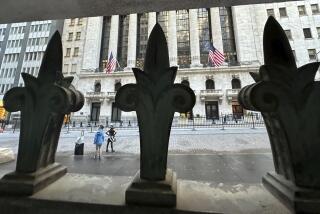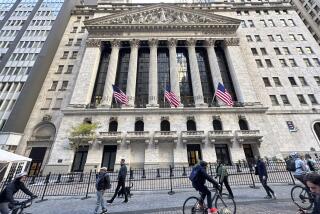Divided Fed to keep interest rates low for two years
Issuing a grim new assessment of the American economy, a divided Federal Reserve said it now expects to hold short-term interest rates near zero for at least two more years.
The central bank’s surprise announcement on rates helped fuel a dramatic turnaround in the stock market, as some investors took comfort in the prospect of more help from the Fed.
The Dow Jones industrial average soared 429.92 points, or 4%, to 11,239.77 on Tuesday, recouping some of its deep losses over the last three weeks as faith in the economic recovery has faded.
“Yes, it’s a dismal outlook,” said Diane Swonk, chief economist at Mesirow Financial in Chicago. But in a market teeming with fatigue and confusion, she said, investors apparently read the Fed statement as somewhat hopeful.
“It’s still growth, it didn’t say double-dip [recession] and the Fed is going to fight it,” Swonk said.
Analysts said the battered market had been primed for a rebound and that investors may turn less enthusiastic as the Fed’s message on the struggling economy sinks in.
But the Fed’s shift on rates could affect spending and investing decisions.
In theory, if businesses and investors believe that short-term rates won’t rise for at least two years, they would have more incentive to do something potentially more productive with their money than keep it in bank accounts earning next to nothing. That could include investing in longer-term Treasury, corporate and municipal bonds.
Some investors rushed to lock in yields on Treasury bonds Tuesday, driving the yield on the bellwether 10-year Treasury note to 2.26%, down from 2.34% on Monday and the lowest since last fall. That could drive mortgage rates lower as well.
For Americans with money in the bank, the Fed’s plans to keep interest rates near rock-bottom will assure that savings will continue to pay little, even as many consumers battle high energy and grocery costs.
After holding its regular midsummer meeting, the Fed’s policymaking committee issued a statement that acknowledged the economy’s recent weakness. Since meeting in late June, the Fed said, it was clear that “economic growth so far this year has been considerably slower than the committee had expected.”
The Fed said it was encouraged by low inflation and still-strong business spending for equipment and software. But the rest of its assessment was bleak. It cited a deterioration in the job market, flattened consumer spending, weak investment in commercial properties and a still-depressed housing market.
“Moreover, downside risks to the economic outlook have increased,” the Fed said.
Against that backdrop, Fed Chairman Ben S. Bernanke and his colleagues said the economy was “likely to warrant exceptionally low levels for the federal funds rate at least through mid-2013.”
The Fed has held the funds rate, its benchmark short-term interest rate, near zero since the depths of the recession in late-2008. Since then, the central bank has typically pledged to continue holding the rate at that level for “an extended period.”
Tuesday’s statement marks the first time that the Fed has pegged a specific timetable to a pledge on its key rate. But the decision wasn’t unanimous: Three of the 10 voting members on the Fed committee dissented.
Voting against the change were Richard W. Fisher, Narayana Kocherlakota and Charles I. Plosser, the heads of the Fed’s Dallas, Minneapolis and Philadelphia branches, respectively.
The statement said the three “would have preferred to continue to describe economic conditions as likely to warrant exceptionally low levels for the federal funds rate for an extended period,” retaining the old language.
Fisher and Plosser have warned repeatedly that the Fed risks stoking inflation or another asset bubble by keeping money too easy for too long.
The dissension on the Fed’s committee could make it tougher for Bernanke to muster support in the months ahead for other potential policy changes, which could include pumping more money into the financial system in an effort to stimulate growth.
With Congress and President Obama seemingly stalemated over major new economic initiatives, and with stock prices tumbling, Wall Street has again been looking to the Fed to provide help for the economy.
The National Federation of Independent Business said Tuesday that its latest survey found that optimism among small businesses fell in July for the fifth month in a row.
“The percent of owners citing poor sales as their top problem has faded a few points, and reports of sales trends are much better than a few months ago” the federation said in a report.
“But that has not been enough to buck up owner optimism. Something else is troubling business owners and consumers,” it said. “Maybe the incompetence of leadership in Washington revealed by the debt-ceiling madness that has taken over the news.”
In its statement, the Fed made explicit that policymakers considered — and were prepared to act on — other policy steps.
Some analysts said they expected the Fed would follow later this year with another round of large-scale Treasury bond purchases that could drive longer-term interest rates even lower.
But many experts note that interest rates aren’t the economy’s real problem: Rather, growth has been held back by low demand for goods and services from both businesses and consumers.
The dissent by the three Fed officials in Tuesday’s vote shows that, on the issue of low interest rates, “we’ve tried this and it hasn’t worked,” said Howard Simons, market strategist at Bianco Research in Chicago.
“The problem is, you’ve kind of used all your ammunition,” said Dean Croushore, chairman of the economics department at the University of Richmond and coauthor of a textbook with Bernanke. “Everything you have is a lot dicier. I think they might want to save any ammunition in case it gets worse.”
Among other policy options, the Fed could commit to maintaining its $2.6-trillion investment bond portfolio for an extended period, which would be akin to keeping money in circulation.
Bernanke also has talked about cutting to zero the 0.25% interest that the Fed pays banks to park their excess cash with the Fed. A lower rate could encourage lenders to put that money into use in the economy.
Some Fed analysts were sharply critical of the language change on interest rates.
“It’s a foolish thing to do because they have no way of knowing what things are going to be like in 2013,” said Allan Meltzer, a Fed historian at Carnegie Mellon University.
The move might be good for stock investors, he said, but it won’t help the broader economy, and will debase the dollar and sow the seeds of inflation.
The dollar tumbled Tuesday after the Fed issued its statement, driving the greenback to a record low against the Swiss franc and near a record low against the Japanese yen.
Gold, which has been rocketing this year as some investors have lost faith in the dollar, zoomed to a record, trading as high as $1,770 an ounce. The price has soared from $1,421 at the start of the year.







